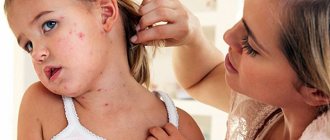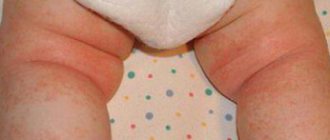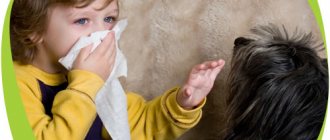December 3, 2020
Contact dermatitis is an inflammation of the skin in an area that has come into contact with an irritating substance or environmental factor. Children under 12 years of age are most susceptible to the disease. The point is the structural features of children's skin and the weakness of its protective mechanisms. The disease manifests itself in any area that has been in contact with the irritant, but more often on the face, arms, neck, and groin area.
If the provoking agent is recognized in time and the child is protected from it, the inflammation is well treated and the symptoms quickly pass. When the cause is difficult to identify or parents do not consult a doctor on time, the course of the disease becomes more severe.
Contact dermatitis occurs:
- simple - local irritation by some factor;
- allergic.
The second option will appear when the child has an increased sensitivity to this substance. The first interaction with it is outwardly unnoticeable, but chemicals are formed in the skin that bind to immune cells - T-lymphocytes. Immune cells remember the stimulus. Upon repeated contact, which can occur after a long time, T-lymphocytes trigger an allergic reaction and cause skin symptoms.
How to recognize allergic contact dermatitis in a child
The contours of the inflammation often coincide with the outlines of the object that caused the irritation. The rash spreads little beyond the area of skin that came into contact with the causative factor. The skin here becomes red and swollen, very itchy, blisters, wounds and crusts appear.
Fungal and bacterial infections easily attach to wounds and suppuration occurs. Babies may experience an increase in general temperature.
Frequent exacerbation in the same places leads to unpleasant outcomes: areas of increased or decreased pigmentation, scars, thickening and roughening of the skin.
If you notice a rash or red spots on your child’s skin, be sure to see a doctor to get tests done to determine the exact cause and begin treatment.
The disease may worsen. To prevent this from happening, you need to find and eliminate the provoking causes.
How to diagnose allergies?
An allergic rash in children is often confused with an infectious one. If the treatment is incorrect, then the consequences of such a therapeutic course will not be the best. Before choosing an effective remedy, you need to learn to distinguish one disease from another. Only a doctor can make an accurate diagnosis, since a visual examination is not always enough to determine the cause of the disease; tests are required.
| Features | Allergic rash | Infection |
| General form | It can be in the form of both small dots and large blisters. In addition to them, there are often crusts, erosions and serous wells (ulcers from which fluid oozes). | The rashes are pinpoint and do not “merge” into a large spot. |
| Place of appearance | Face (forehead, cheeks, chin). Neck, arms, legs, buttocks. Rarely – stomach, back. | Belly, back. Rarely – arms, legs. Very rarely - forehead. |
| Heat | The temperature is rare, and if it rises, it is not higher than 37-38°C. | The disease is accompanied by fever, from 37°C to 41°C. |
| Itching | Happens. | Happens. |
| Swelling | Well visible. In some situations it is life-threatening. | They happen very rarely. |
| Associated symptoms | Lacrimation, conjunctivitis, hyperemia of the mucous membrane of the eye, decreased blood pressure, cough, upset stomach. | Running nose, general loss of strength, body aches. |
| How quickly it goes | Often the rash goes away immediately after taking the medicine. | Remains until the course of treatment is completed. |
External causes of the development of allergic dermatitis in children
The disease can be caused by one of the factors or a combination of several.
- Physical - friction or pressure on the skin of fabrics, leather products, high or low temperatures, humidity, electric current, ultraviolet or x-rays.
- Chemical - various acids and alkalis, substances included in creams and hygiene products, medicines, tobacco smoke.
- Biological - sap and pollen of plants, bites and secretions of insects and animals.
Of the plant agents, the most dangerous are the juice of celandine, hogweed, nettle, pollen of meadow and weeds.
In industrial cities in winter, there are widespread cases of contact dermatitis under the eyes and on the hands of children. Three factors are combined here: cold, chemical impurities in the air and touching the skin with wet mittens.
In infants, allergic inflammation can be caused by a combination of high humidity in diapers, fabric friction and the action of inappropriate cream.
A special type of contact dermatitis is phototoxic, when sunscreens degrade in sunlight and cause allergic damage to the epidermis.
Associated diseases
Prickly heat
A disease characterized by the formation of small blisters or pimples. It is provoked by elevated temperature, steaming the body with warm or synthetic clothing that does not allow air to pass through. It often occurs in the groin area, in the folds under the knees, and in the armpit area.
Miliaria is distinguished:
- papular (associated with the appearance of papules: the skin dries very much, peels and itches);
- red (distinguished by red blistering and nodular formations up to 2 mm with cloudy liquid inside, itching);
- crystalline (characterized by the presence of white and transparent bubbles with a diameter of up to 1 mm.).
Treatment of the disease is associated with the elimination of provoking factors (overheating) and compliance with the necessary hygienic conditions.
You can relieve the symptoms of the disease with the help of creams and gels: “La-Cri” (safe for infants, pregnant women), “Bepanten”, etc.
Hormonal imbalance and vitamin deficiency
Changes in hormonal levels (during puberty, in case of disturbances in the functioning of internal organs involved in the production of hormones) can cause acne to appear on the legs. The disease manifests itself individually, and peeling of the skin may occur.
Dermatitis in a child and psychosomatics
Skin health directly depends on a person’s mental well-being. Stress changes hormonal levels and metabolism, causing disruptions in the functioning of the immune system. Therefore, a calm emotional state will prevent exacerbation of the disease and delay the first appearance of symptoms.
When faced with contact dermatitis, analyze the causes and identify the allergen that caused it.
It's not always easy. To be sure of the correct diagnosis, conduct the necessary tests and receive treatment, come for a consultation at our center. In addition to treatment, you will learn how to properly prevent this disease. December 3, 2020
Author of the article: dermatologist Mak Vladimir Fedorovich
Hand-foot-mouth syndrome or enteroviral vesicular stomatitis with exanthema
These viruses are quite widespread among the population, but most often affect children under 5 years of age. The disease is more common in the spring-autumn period, sometimes there is a seasonal increase in incidence upon the return of children after vacationing from southern resorts. The infection is transmitted by airborne droplets, and also has a fecal-oral transmission mechanism, i.e. In addition to sneezing and coughing, transmission factors can include toys, dishes and household items.
Viruses of this family are quite stable in the external environment - they can remain viable at room temperature for up to 2 weeks.
This is an acute infectious disease caused by RNA viruses of the picornavirus family: Coxsackie viruses A16, A5, A10, A9, B1, B3 and enterovirus 71.
Based on the characteristic clinical picture, the disease is called “hand-foot-mouth” syndrome (or enteroviral vesicular stomatitis with exanthema) derived from the English Hand-Foot-and-Mouth Disease (HFMD) and is a symptom complex consisting of lesions of the oral mucosa - enanthema and the appearance of a rash on the upper and lower extremities - exanthema.
The incubation period lasts from several days to 1 week. The first manifestations of the disease are an increase in temperature to 37.5-38.5 degrees, a feeling of malaise, weakness, headache, and sore throat. These symptoms persist for several days and are very similar to the symptoms of any ARVI. But unlike ARVI, after 1-2 days on the skin of the hands, palms, and soles; somewhat less frequently, a rash appears on the thighs and forearms in the form of vesicles with transparent contents against a red-pink background. The vesicles are generally the size of a match head. Similar rashes appear in the mouth area and in the oral cavity itself - they are in the nature of microulcers (ulcers), painful and sensitive to contrasting foods. All eruptive elements tend to reverse within a few days.
Resolving rashes in the area of the palms and soles can leave quite pronounced peeling for some time and, what is typical, some patients experience peeling and cracking of the nail plates (onychodystrophy) after a short amount of time, which is especially frightening for parents and often serves as a reason to look for a fungal infection . These manifestations are also completely reversible.
The prognosis of the disease is most often favorable. Spontaneous recovery occurs. It is necessary to isolate the child from other children, because it is extremely contagious for children's groups. All therapy comes down to symptomatic drugs (antipyretics, antihistamines), local solutions of aniline dyes for vesicles (Fukortsin), rinsing the mouth with weak solutions of antiseptics (miramistin, chamomile decoction), drinking plenty of fluids and a gentle diet is recommended. However, rarely, complications such as the development of meningitis and encephalitis are possible. Alarming symptoms of “hand-foot-mouth” disease, which will allow you to suspect an unfavorable course of the disease and require an urgent call to a doctor: fever above 39º, persistent high temperature, vomiting (sometimes multiple times), increased headache, pain in the eyeballs, constant crying and capriciousness of the child against the background of fever, constant drowsiness or, conversely, psychomotor agitation of the patient. If such symptoms appear, you should immediately call emergency medical help.
If you suspect hand-foot-mouth syndrome, you can always consult pediatricians, infectious disease specialists and dermatologists at the clinic by phone / +7 495 735-88-77
or make an appointment via the feedback form
Yours sincerely,
Dermatologist A.Yu. Putintsev
Causes and risk factors of acne
Acne develops around the hair follicles and is caused by excessive sebum production. Increased secretion of sebum in combination with the presence of dead skin cells on the epidermis leads to clogging of the follicles of the hair shaft, which is accompanied by the appearance of comedones.
Comedones are the same tiny sores with a white tip that turn black when exposed to oxygen. Exacerbation of acne is caused by the involvement of an infectious process. A moist and oily environment is a favorable substrate for the proliferation of acne bacilli (Propionibacterium acnes).
When the bacteria is present, an inflammatory reaction develops, with pimples forming a red plaque on the top of the skin. The final sign of acne is nodular acne, characterized by large inflammatory lesions that can hurt and even leave scars after recovery.
There are several factors that increase the likelihood that a child will develop acne:
- using skin and hair care products that contain chemicals that irritate the skin;
- using alkaline soap and very hot water;
- squeezing pimples and scratching affected areas of the skin;
- frequent stressful situations or constant nervous tension;
- excessive sweating and dandruff.
Learning what causes acne in children can help find ways to prevent and treat the disease. This allows the child to overcome the stress and depression that he experiences due to acne on his skin.
Endocrinopathies can be the cause of childhood acne. That is why, if you have acne, you should definitely consult a doctor to rule out such severe pathologies as congenital adrenal hyperplasia, malignant testicular tumors and polycystic ovary syndrome.
Causes of rashes
The reasons are physiological, which are provided by a natural response to an internal process in the body. There may also be pathological causes that develop against the background of:
- disorders under the influence of parasites;
- chemical and toxic substances;
- metabolic disorders;
- lack of certain vitamins;
- dysbacteriosis;
- gastrointestinal and renal function disorders;
- external and internal factors.
As a result, we can conclude that rashes in childhood do not appear without a reason.
It seems to parents that all rashes are almost the same. However, there is a primary rash, which formed first, and a secondary one, which developed over time, instead of or near the primary one.
Prevention
To reduce the risk of infection, you should follow the following rules:
- follow the rules of hygiene,
- disinfect damage to the skin,
- strengthen the name system with useful substances,
- do not carry out frequent water procedures, as this may pose a certain danger for the child,
- In case of primary symptoms, you should immediately consult a doctor.
Streptoderma on the face can be treated, but only if you consult a doctor in a timely manner. The earlier therapy was carried out, the easier it is to exclude complications and transition to the chronic stage. You can undergo a full examination in a clinical clinic.
First aid and treatment
If children develop an allergic rash on their skin, it is strictly forbidden to squeeze pimples or open blisters. It is necessary to explain to the child that it is also forbidden to scratch the sores.
If he is still too small, make sure that he does not touch the wounds with dirty hands. He can get an infection, and this will only worsen his condition.
Treatment of rashes in children is selected depending on the type of disease. Parents who do not know how to treat allergic rashes in children should not select medications on their own.









